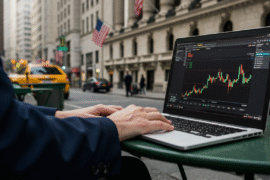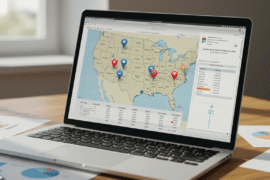This article may contain references to products or services from one or more of our advertisers or partners. We may receive compensation when you click on links to those products or services. Nonetheless, our opinions are our own.
The information presented in this article is accurate to the best of our knowledge at the time of publication. However, information is subject to change, and no guarantees are made about the continued accuracy or completeness of this content after its publication date.
To be able to trade stocks well, you need to know a lot about how the economy works, how industries change, and how investors feel. Cisco Systems, Inc. (CSCO) is a major player in the networking and cybersecurity business, and it has been seen as a safe investment for a long time. But recent events show that institutional investors are becoming more cautious about their investments in the company. This change makes us think about the reasons behind the market’s uncertainty and what it means for people who own Cisco stock.
We’ll look at why experienced investors are using hedging strategies, the risks that could hurt Cisco’s market position, and the tools that are available to protect investments in a financial environment that is hard to predict.
- Shifting Market Landscape: Cisco’s Position Amid Economic Uncertainty
- Why Institutional Investors Are Hedging Their Positions
- Risk Management Strategies for Investors
- Positioning for Long-Term Stability
- Conclusion
- Frequently Asked Questions
- Why are institutional investors hedging their positions in Cisco (CSCO)?
- What are the biggest risks currently facing Cisco?
- How can individual investors protect themselves amid CSCO volatility?
- Is Cisco still a good long-term investment?
- What does the increase in Cisco’s short interest mean?
- What is a protective put and how can it help?
- How does diversification help in managing Cisco-related risk?
- Are there other tech stocks showing similar hedging activity?
- What financial metrics should I watch to assess Cisco’s strength?
- Should I sell my Cisco shares because institutions are hedging?
- Recommended Reads
Shifting Market Landscape: Cisco’s Position Amid Economic Uncertainty
Cisco has historically benefited from its strong market presence, extensive product portfolio, and continued innovation in enterprise networking. Yet, the broader economic environment and technological advancements are influencing investor sentiment. A mix of external pressures, including inflation, interest rate fluctuations, and emerging competition, is prompting a more cautious outlook.
Factors Influencing Investor Sentiment
- Economic Climate: Rising interest rates often dampen the performance of technology stocks, making high-valuation companies like Cisco more vulnerable to market corrections.
- Industry Disruptions: The rapid adoption of cloud-based solutions and software-defined networking (SDN) is shifting the competitive landscape, putting pressure on traditional hardware-based revenue streams.
- Institutional Moves: Hedge funds and large-scale investors are increasingly incorporating downside protection strategies, as seen in options market trends and changes in short interest.
Why Institutional Investors Are Hedging Their Positions
Market Volatility and Macroeconomic Pressures
The broader economic climate plays a significant role in investment strategies. Federal Reserve policies and inflationary concerns contribute to fluctuations in stock prices, particularly within the technology sector. As borrowing costs rise, growth-oriented companies such as Cisco may experience downward pressure, prompting investors to implement hedging strategies.
Competitive Pressures and Industry Shifts
Cisco remains a leader in networking and cybersecurity, yet it faces mounting challenges from companies like Arista Networks, Juniper Networks, and smaller cloud-native firms. The shift toward AI-driven automation, software-based networking, and cloud infrastructure services could limit Cisco’s growth trajectory in certain market segments.
Options Market and Institutional Activity
A closer look at options trading data reveals that institutional investors are purchasing more put options, signaling concerns about potential price declines. Additionally, short interest in Cisco stock has risen, reflecting growing skepticism about its near-term performance.
| Indicator | Current Status | Implications |
|---|---|---|
| Debt-to-Equity Ratio | 1.25 | Elevated risk level |
| Annual Revenue Growth (%) | 3% | Lagging behind competitors |
| Dividend Payout Ratio (%) | 60% | Reduced reinvestment flexibility |
These factors suggest that professional investors are exercising caution, even as Cisco continues to report stable earnings.
Voted "Best Overall Budgeting App" by Forbes and WSJ
Monarch Money helps you budget, track spending, set goals, and plan your financial future—all in one app.
Get 50% OFF your first year with code MONARCHVIP
Risk Management Strategies for Investors
Adopting a proactive approach to risk management can help investors navigate uncertain market conditions. While institutional investors have access to sophisticated hedging tools, individual investors can also take steps to protect their portfolios.
Diversification and Asset Allocation
Spreading investments across multiple sectors can mitigate exposure to Cisco’s stock price fluctuations. Diversification reduces the impact of volatility in any single industry and provides stability in times of market downturns.
Protective Measures for Stock Holdings
- Stop-Loss Orders: Setting predefined price levels for selling shares can prevent excessive losses during sharp market declines.
- Options Hedging: Utilizing put options or protective collars can help offset potential declines in Cisco’s stock value while preserving upside potential.
Positioning for Long-Term Stability
While short-term market fluctuations may influence investor behavior, a well-structured investment strategy accounts for both risk and opportunity. Maintaining a diversified portfolio, closely monitoring industry developments, and evaluating Cisco’s financial health on an ongoing basis can help investors make informed decisions.
Balanced Portfolio Allocation
| Asset Class | Percentage Allocation |
|---|---|
| Cisco (CSCO) | 20% |
| Tech Stocks | 30% |
| Bonds | 25% |
| Real Estate | 15% |
| Cash/Equivalents | 10% |
Implementing a disciplined investment approach allows for adjustments as market conditions evolve. Whether through diversification, hedging, or adjusting asset allocations, careful planning helps mitigate risks while maintaining exposure to growth opportunities.
Conclusion
The rise in hedging activity around Cisco Systems (CSCO) is a sign of a larger trend of caution among institutional investors. Uncertain economic conditions, competition, and changes in the industry are all making people more careful about investing in the company.
Investors can deal with market volatility in a balanced way by learning why these institutions are making these moves and using risk-management strategies. Aligning your investment choices with what is happening in the market can help you keep your money safe and set yourself up for long-term success, whether you do this through diversification, stop-loss orders, or options hedging.
Frequently Asked Questions
Why are institutional investors hedging their positions in Cisco (CSCO)?
Institutional investors are using more hedging strategies, like put options and short positions, because the economy is uncertain, interest rates are going up, and there is more competition in the networking and cybersecurity sectors. These steps help keep portfolios safe from possible losses.
What are the biggest risks currently facing Cisco?
Cisco faces several risks:
Macroeconomic pressures like inflation and interest rate hikes
Industry disruption from cloud-native competitors and AI-driven networking
Slower revenue growth compared to peers
High dividend payout ratio, which may limit reinvestment in innovation
How can individual investors protect themselves amid CSCO volatility?
Retail investors can use several strategies:
Diversify across sectors to reduce exposure to one stock
Set stop-loss orders to limit downside risk
Use protective puts or option collars if options trading is accessible
Monitor financial indicators like debt-to-equity and revenue growth
Is Cisco still a good long-term investment?
Cisco maintains strong fundamentals, consistent dividends, and a dominant position in enterprise networking. However, slow growth and emerging competition may limit upside. Long-term potential exists, but investors should balance their exposure and monitor trends.
What does the increase in Cisco’s short interest mean?
A rise in short interest indicates that more investors expect the stock to decline in the near term. While not a guaranteed signal, it often reflects market skepticism about a company’s growth or valuation under current conditions.
What is a protective put and how can it help?
A protective put is a type of options contract that lets the investor sell a stock for a certain price. It works like insurance: if Cisco’s price drops below the strike price, the put’s value goes up, making up for losses.
Diversification spreads investment across different asset classes (stocks, bonds, real estate, cash), reducing the impact of a poor-performing stock like CSCO on the overall portfolio. It’s a key strategy in risk management.
Are there other tech stocks showing similar hedging activity?
Yes. Institutional investors are also showing caution with other large-cap tech names, especially those with slower earnings growth or high sensitivity to rate hikes (e.g., Intel, IBM). The trend reflects broader concerns in the tech sector.
What financial metrics should I watch to assess Cisco’s strength?
Debt-to-Equity Ratio (currently 1.25): Measures leverage risk
Revenue Growth (3% annually): Gauges business momentum
Dividend Payout Ratio (60%): Indicates sustainability of dividends
Tracking these helps investors judge financial health and performance.
Not necessarily. Hedging by institutions doesn’t always indicate a company is failing—it can be a precautionary measure. Investors should consider their time horizon, financial goals, and overall portfolio before making a decision.

Reviewed and edited by Albert Fang.
See a typo or want to suggest an edit/revision to the content? Use the contact us form to provide feedback.
At FangWallet, we value editorial integrity and open collaboration in curating quality content for readers to enjoy. Much appreciated for the assist.
Did you like our article and find it insightful? We encourage sharing the article link with family and friends to benefit as well - better yet, sharing on social media. Thank you for the support! 🍉
Article Title: Why Institutions Are Hedging Against a Cisco Stock Downturn
https://fangwallet.com/2025/07/19/why-institutions-are-hedging-against-a-cisco-stock-downturn/The FangWallet Promise
FangWallet is an editorially independent resource - founded on breaking down challenging financial concepts for anyone to understand since 2014. While we adhere to editorial integrity, note that this post may contain references to products from our partners.
The FangWallet promise is always to have your best interest in mind and be transparent and honest about the financial picture.
Become an Insider

Subscribe to get a free daily budget planner printable to help get your money on track!
Make passive money the right way. No spam.
Editorial Disclaimer: The editorial content on this page is not provided by any of the companies mentioned. The opinions expressed here are the author's alone.
The content of this website is for informational purposes only and does not represent investment advice, or an offer or solicitation to buy or sell any security, investment, or product. Investors are encouraged to do their own due diligence, and, if necessary, consult professional advising before making any investment decisions. Investing involves a high degree of risk, and financial losses may occur including the potential loss of principal.
Source Citation References:
+ Inspo
There are no additional citations or references to note for this article at this time.











































